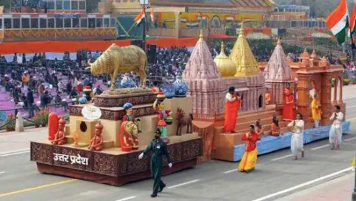Context
In the backdrop of repeated controversies over selection of tableaux for the Republic Day parade and complaints from the States year after year, the Defence Ministry has proposed a rollover plan for the States and Union Territories (UT) to showcase their tableaux.
Republic Day

- Every year on January 26th, Republic Day is an annual celebration to mark the adoption of the Indian Constitution and India’s transition to a democratic republic.
- The first parade took place in 1950 and it has taken place every year since.
- Led by the President from the Kartavya Path in New Delhi, the parade exhibits military might and cultural heritage, which includes tableaux rolled out by States, Union Territories, Central ministries and departments.
Who is conducting Parade?
- The Ministry of Defence (MoD) is responsible for conducting the parade and coordinating arrangements with States and other agencies.
- Preparations for the ceremony, which has become synonymous with national pride and patriotism, begin months in advance.
- According to a Ministry of Defence (MoD) circular dated October 30, 2023, each year, a select number of “State Governments/UT Administrations/Central/Ministries/Departments” send their tableaux to the Republic Day parade.
- There is a rigorous application process which begins with interested parties submitting a concept note, along with design blueprints to the MoD.
- The deadline for submissions to participate in this year’s parade was November 10, 2023.
- This process includes the selection and shortlisting of tableaux.
How does the selection process work?
- The tableaux proposals received are evaluated by a committee of experts appointed by the MoD, comprising prominent persons in the field of art, culture, painting, sculpture, music, architecture, choreography, etc.
The selection process happens in a phased manner.
- STAGE 1 involves the assessment of the initial proposals and the design sketch/blueprint.
- The Committee sits alongside official representatives of the participants and suggests modifications, if necessary. A number of proposals may be rejected in this stage itself.
- STAGE 2 involves assessment of three-dimensional models of the proposals. If the Committee is satisfied with the model, then the tableau is selected and further sent for fabrication.
- The Committee can also suggest changes to models before selection.
Crucially, while the process is envisioned to be collaborative, the Committee has the final say on which tableaux are chosen, and can order any modifications they feel are required.
What is the basis of selection?
- Selection depends upon a combination of factors including but not limited to visual appeal, impact on the masses, idea/theme of the tableaux, degree of detailing involved in the tableaux, music accompanying the tableaux, local artists used etc.
- Each year, the MoD comes up with an overarching theme, under which, participants can showcase elements relevant to their respective state/UT/department in their tableaux.
- This year’s theme is “Viksit Bharat” (Developed India) and “Bharat: Loktantra ki Matrika” (India: the Mother of Democracy).
The Defence Ministry also shares the basic guidelines about what all the tableaux can or should include:
- The participating entities must engage “young qualified designers from renowned institutions”, electronic display walls for a bright display of images or content, moving elements using robotics or mechatronics, 3D printing could be used for certain elements, use of augmented or virtual reality, and special effects to improve the optics and visual effects of the tableau.
- Extra weightage is given to tableaux which conform to these guidelines.
- Importantly, the tableaux of two different states/ UTs must not be too similar, and eco-friendly material must be used for their construction.
Defence Ministry’s new rollover plan for Republic Day parade tableaux selection
- Approximately 15 tableaux from the States and Union Territories are selected for the Republic Day parade every year.
- A three-year memorandum of understanding (MoU) has been proposed. Subsequently, a draft agreement was circulated and 28 States have signed it so far.
- So everyone cannot be accommodated each year. Under the agreement, every State and UT will get an opportunity within three years.
- This is to ensure equitable distribution.
- To fast-track the participation of tableaux year-wise, willingness of States and UTs was sought in advance for the next three years for their participation in Republic Day Parade, 2024, 2025 and 2026.

